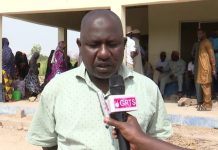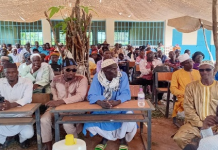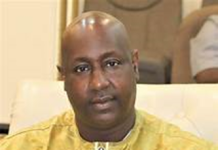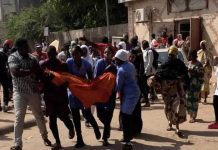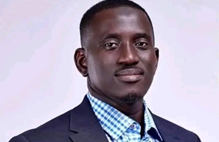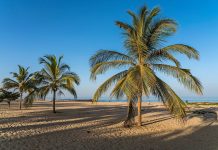by Ousman Sillah
“I am in my late thirties. Can you believe it? I used to work for the Area Council and  had to leave the job after I was diagnosed with Tuberculosis (TB). I was like skin and bone and had to go through many herbal treatments without seeing any improvement. My family started to distance themselves from me when they suspected that I had contracted HIV/AIDS. I had to go and reside in an unfinished house in the outskirts because of the isolation. I would have died if it were not for this support society that gave me hope and company as well as the opportunity to receive regular ARV treatment and food rations,” said the woman I met at the monthly meeting of one of the support groups for persons living with HIV/AIDS (PLWHA). “If I had this earlier, maybe there would not have been the need to lose my job and family ties,” she added.
This woman is not alone. Other women in the group, which is affiliated to the Gambia Network of AIDS Support Societies (GAMNASS), narrated similar stories of the ignorance and stigma that they face when diagnosed HIV positive.
Evidence of people increasingly relying on the ARV drugs for the treatment of HIV abound. AmadouDia, the president of a support group of PLWHA in Senegal, just last week on 2stv, a private Senegalese television station, said he has been living with HIV for more than a decade now and is still surviving, thanks to the antiretroviral treatment (ART). He was invited to this popular television programme ‘Senegal CaKanam’ to a debate with CheikhMadiagneCamara, a traditional healer, who claims that he cures HIV/AIDS.
“I know I will go to my grave with the virus. However, I am confident that AIDS will not be the cause of my death because of ARV,” he said.
Mr. Dia expressed his conviction that both conventional and non-conventional (traditional) medicine have not yet found the cure for HIV, but that the antiretroviral can help weaken the virus in the body and thus enable the infected person to live healthily.
“I don’t deny the fact that traditional medicine can and does cure some ailments, but for HIV/AIDS let us be shown proves that there is a cure,’ he challenged.
What these remarks highlight, however, is the dangers involved in going for herbal treatment without proper diagnosis and the importance of early detection, early treatment and the timely use of anti-retroviral (ARV) drugs as well as access to proper nutrition as means to contain the HIV infection.
Antiretroviral or ARV drugs are medication used in the treatment of HIV infection. Although not a cure, ARV keeps the amount of HIV in the body at a low level and can stop people living with it from becoming ill for many years.
ARV drug (blue), multi-vitamin (red) and septrin (white) tablets
had to leave the job after I was diagnosed with Tuberculosis (TB). I was like skin and bone and had to go through many herbal treatments without seeing any improvement. My family started to distance themselves from me when they suspected that I had contracted HIV/AIDS. I had to go and reside in an unfinished house in the outskirts because of the isolation. I would have died if it were not for this support society that gave me hope and company as well as the opportunity to receive regular ARV treatment and food rations,” said the woman I met at the monthly meeting of one of the support groups for persons living with HIV/AIDS (PLWHA). “If I had this earlier, maybe there would not have been the need to lose my job and family ties,” she added.
This woman is not alone. Other women in the group, which is affiliated to the Gambia Network of AIDS Support Societies (GAMNASS), narrated similar stories of the ignorance and stigma that they face when diagnosed HIV positive.
Evidence of people increasingly relying on the ARV drugs for the treatment of HIV abound. AmadouDia, the president of a support group of PLWHA in Senegal, just last week on 2stv, a private Senegalese television station, said he has been living with HIV for more than a decade now and is still surviving, thanks to the antiretroviral treatment (ART). He was invited to this popular television programme ‘Senegal CaKanam’ to a debate with CheikhMadiagneCamara, a traditional healer, who claims that he cures HIV/AIDS.
“I know I will go to my grave with the virus. However, I am confident that AIDS will not be the cause of my death because of ARV,” he said.
Mr. Dia expressed his conviction that both conventional and non-conventional (traditional) medicine have not yet found the cure for HIV, but that the antiretroviral can help weaken the virus in the body and thus enable the infected person to live healthily.
“I don’t deny the fact that traditional medicine can and does cure some ailments, but for HIV/AIDS let us be shown proves that there is a cure,’ he challenged.
What these remarks highlight, however, is the dangers involved in going for herbal treatment without proper diagnosis and the importance of early detection, early treatment and the timely use of anti-retroviral (ARV) drugs as well as access to proper nutrition as means to contain the HIV infection.
Antiretroviral or ARV drugs are medication used in the treatment of HIV infection. Although not a cure, ARV keeps the amount of HIV in the body at a low level and can stop people living with it from becoming ill for many years.
ARV drug (blue), multi-vitamin (red) and septrin (white) tablets
 It is not just a matter of drugs
Studies have established that good nutrition which means eating the right kinds and amounts of food boosts the body’s immune system to fight infection and enhance the effectiveness of Anti-Retroviral Treatment (ART). A technical report on Nutrient Requirements for People Living with HIV/AIDS commissioned by the World Health Organisation (WHO) in May 2003, has recommended for focus on nutrition as a fundamental part of the comprehensive package of national AIDS control, treatment and care programmes.
The conventional approach conceives Human Immunodeficiency Virus/Acquired Immunodeficiency Syndrome (HIV/AIDS) as a disease of the human immune system and that as of now there is no cure. Hence, particular emphasis is placed on prevention, management and care.
Evidence has shown that people living with HIV/AIDS are using conventional or non-conventional (traditional medicine) or both methods to treat the illness. In some sub-Saharan African countries, HIV/AIDS prevalence is actually managed, while in others the prevalence is increasing. Why?
This begs for an answer. It is therefore a matter of public interest to find out how the illness is being treated in two countries, namely the Gambia and Senegal, which share boundaries and cultural heritage.
Claims and counter claims of a cure
“Cowries, rosary beads and ‘Listikhar’ (prayers) cannot see or treat the HIV virus,” revealed a composed Mamadou Ba, President of GESTU, the Senegalese organisation of traditional medicine practitioners (tradipracticians), who also doubles as the President of the network of tradipracticians in West Africa.
However, he added that “As Africans who have survived through the ages and using herbs to treat illnesses, we should not condemn the practice of traditional medicine. We should try and integrate the practice and make it adapt to modern scientific methods.”
The Gambian head of state, President YahyaJammeh, earlier this year, declared 17th January National Traditional Medicine Day. The President’s focus on using traditional African medicinal practices to cure disease is not new. In 2007, he took the world by storm in declaring that he has found a cure for HIV/AIDS and eventually set up the President’s Alternative Treatment Programme. 7 years later, the programme continues to receive patients. I took interest in trying to find out how many people are living with HIV/AIDS in The Gambia, how many had undergone the treatment under the president’s programme, the method adopted in diagnosing the patient, the type of treatment that is administered and whether it is exclusively non-conventional (traditional), the number of people cured and the follow up programme to monitor whether or not there are relapses.
However, all attempts to get official statistics from the National AIDS Secretariat (NAS) and the essence of the breakthrough from Dr. TamsirMbowe, the Director of the Programme, proved negative due to their insistence on getting clearance from the Office of the President, even though a letter from the said office which indicates that I could use footages of the treatment programme was shown to them.
The President of the Senegalese tradipracticians, however, has emphasized the importance of non-conventional medicine to be subjected to regulation and scientific validation to prevent abuse.
That perspective is buttressed by Dr. Col. SeyniNdoye, Coordinator of Strategic Communication at the Conseil National de Luttecontre le Sida (CNLS), Hence, the key perspective in Senegal is that HIV/AIDS is yet to have a cure and that all interventions to its treatment should be subjected to scientific validation and regulation.
In the case of The Gambia, the perspective being conveyed in the official media is that there is a breakthrough. But what is found on the ground is that the patients who are interviewed are relying on antiretroviral drugs and good nutrition provided by support societies.
In terms of regulation, Mr. BubacarSillah, Programme Manager, National Traditional Medicine Programme, under the Ministry of Health and Social Welfare, said “There is no legislation on Traditional Medicine in The Gambia.”
He said the Traditional Medicine Policy, which was formulated in 2005, deals with the regulation of traditional medicine practice, touching on storage, dosaging, etc. of medicinal plants as well as ethics in traditional medicinal practice but that it needs review.
Radio advertisements by herbalists abound in The Gambia and when I ventured to interview some of the most prominent herbalists in the country, my request did not fall in favour. One thing that is very apparent from the adverts is the claim to be able to cure most ailments that are known to patients. In the absence of a regulation and its enforcement, a trial and error in treating illnesses could transform many of them into guinea-pigs.
Hence raising the urgency of a legislation to ensure regulation and prevent abuse before focusing on promotion.
In the case of HIV/AIDS, what we do know is that the prevalence is higher in The Gambia than in Senegal. The prevalence rate in Senegal, which is among the lowest in Africa, is 0.7 percent, while it is 1.5 % in The Gambia, according to the UNAIDS report on the global AIDS epidemic 2013.
The latest figures on HIV prevalence by socio-economic characteristics in The Gambia is 1.8% for male from 15-59 years and 2.1 % for female from 15-49 years, according to the Gambia Demographic and Health Survey in 2013 (GDHS 2013).
HIV prevalence survey of HIV 1 (green) and HIV 2 (blue) in The Gambia
It is not just a matter of drugs
Studies have established that good nutrition which means eating the right kinds and amounts of food boosts the body’s immune system to fight infection and enhance the effectiveness of Anti-Retroviral Treatment (ART). A technical report on Nutrient Requirements for People Living with HIV/AIDS commissioned by the World Health Organisation (WHO) in May 2003, has recommended for focus on nutrition as a fundamental part of the comprehensive package of national AIDS control, treatment and care programmes.
The conventional approach conceives Human Immunodeficiency Virus/Acquired Immunodeficiency Syndrome (HIV/AIDS) as a disease of the human immune system and that as of now there is no cure. Hence, particular emphasis is placed on prevention, management and care.
Evidence has shown that people living with HIV/AIDS are using conventional or non-conventional (traditional medicine) or both methods to treat the illness. In some sub-Saharan African countries, HIV/AIDS prevalence is actually managed, while in others the prevalence is increasing. Why?
This begs for an answer. It is therefore a matter of public interest to find out how the illness is being treated in two countries, namely the Gambia and Senegal, which share boundaries and cultural heritage.
Claims and counter claims of a cure
“Cowries, rosary beads and ‘Listikhar’ (prayers) cannot see or treat the HIV virus,” revealed a composed Mamadou Ba, President of GESTU, the Senegalese organisation of traditional medicine practitioners (tradipracticians), who also doubles as the President of the network of tradipracticians in West Africa.
However, he added that “As Africans who have survived through the ages and using herbs to treat illnesses, we should not condemn the practice of traditional medicine. We should try and integrate the practice and make it adapt to modern scientific methods.”
The Gambian head of state, President YahyaJammeh, earlier this year, declared 17th January National Traditional Medicine Day. The President’s focus on using traditional African medicinal practices to cure disease is not new. In 2007, he took the world by storm in declaring that he has found a cure for HIV/AIDS and eventually set up the President’s Alternative Treatment Programme. 7 years later, the programme continues to receive patients. I took interest in trying to find out how many people are living with HIV/AIDS in The Gambia, how many had undergone the treatment under the president’s programme, the method adopted in diagnosing the patient, the type of treatment that is administered and whether it is exclusively non-conventional (traditional), the number of people cured and the follow up programme to monitor whether or not there are relapses.
However, all attempts to get official statistics from the National AIDS Secretariat (NAS) and the essence of the breakthrough from Dr. TamsirMbowe, the Director of the Programme, proved negative due to their insistence on getting clearance from the Office of the President, even though a letter from the said office which indicates that I could use footages of the treatment programme was shown to them.
The President of the Senegalese tradipracticians, however, has emphasized the importance of non-conventional medicine to be subjected to regulation and scientific validation to prevent abuse.
That perspective is buttressed by Dr. Col. SeyniNdoye, Coordinator of Strategic Communication at the Conseil National de Luttecontre le Sida (CNLS), Hence, the key perspective in Senegal is that HIV/AIDS is yet to have a cure and that all interventions to its treatment should be subjected to scientific validation and regulation.
In the case of The Gambia, the perspective being conveyed in the official media is that there is a breakthrough. But what is found on the ground is that the patients who are interviewed are relying on antiretroviral drugs and good nutrition provided by support societies.
In terms of regulation, Mr. BubacarSillah, Programme Manager, National Traditional Medicine Programme, under the Ministry of Health and Social Welfare, said “There is no legislation on Traditional Medicine in The Gambia.”
He said the Traditional Medicine Policy, which was formulated in 2005, deals with the regulation of traditional medicine practice, touching on storage, dosaging, etc. of medicinal plants as well as ethics in traditional medicinal practice but that it needs review.
Radio advertisements by herbalists abound in The Gambia and when I ventured to interview some of the most prominent herbalists in the country, my request did not fall in favour. One thing that is very apparent from the adverts is the claim to be able to cure most ailments that are known to patients. In the absence of a regulation and its enforcement, a trial and error in treating illnesses could transform many of them into guinea-pigs.
Hence raising the urgency of a legislation to ensure regulation and prevent abuse before focusing on promotion.
In the case of HIV/AIDS, what we do know is that the prevalence is higher in The Gambia than in Senegal. The prevalence rate in Senegal, which is among the lowest in Africa, is 0.7 percent, while it is 1.5 % in The Gambia, according to the UNAIDS report on the global AIDS epidemic 2013.
The latest figures on HIV prevalence by socio-economic characteristics in The Gambia is 1.8% for male from 15-59 years and 2.1 % for female from 15-49 years, according to the Gambia Demographic and Health Survey in 2013 (GDHS 2013).
HIV prevalence survey of HIV 1 (green) and HIV 2 (blue) in The Gambia
 Source: UNAIDS Country report 2013
From 2001-2012, Senegal was estimated to have 27,000 and 43, 000 people living with HIV (all ages) respectively and that the current prevalence rate is 0.7% of its population, according to the UNAIDS report on the global AIDS epidemic 2013.
Percentage of seropositive from 15-49 years per region
Source: UNAIDS Country report 2013
From 2001-2012, Senegal was estimated to have 27,000 and 43, 000 people living with HIV (all ages) respectively and that the current prevalence rate is 0.7% of its population, according to the UNAIDS report on the global AIDS epidemic 2013.
Percentage of seropositive from 15-49 years per region
 Source: EDS-MICS, Senegal 2010-11
HIV/AIDS prevalence remains a major health challenge in Sub-Saharan Africa. Since 1981 when it was first discovered in the United States, HIV/AIDS has been identified as a life threatening illness which requires concerted efforts to contain. This has led to conventional and non-conventional (traditional medicine) approaches in providing treatment to the ailment. Despite all these approaches, HIV/AIDS prevalence in Sub-Saharan Africa is generally on the increase. According to the UNAIDS Global and Regional statistics, 35. 3 million people were living with HIV globally in 2012 and of which 25 million were in Africa. The same figures revealed that in 2012, 1.6 million of the 2.3 million new global infections were in Africa, while the 1.2 million of the 1.6 million AIDS related deaths globally in 2012 were also registered in Africa.
Source: EDS-MICS, Senegal 2010-11
HIV/AIDS prevalence remains a major health challenge in Sub-Saharan Africa. Since 1981 when it was first discovered in the United States, HIV/AIDS has been identified as a life threatening illness which requires concerted efforts to contain. This has led to conventional and non-conventional (traditional medicine) approaches in providing treatment to the ailment. Despite all these approaches, HIV/AIDS prevalence in Sub-Saharan Africa is generally on the increase. According to the UNAIDS Global and Regional statistics, 35. 3 million people were living with HIV globally in 2012 and of which 25 million were in Africa. The same figures revealed that in 2012, 1.6 million of the 2.3 million new global infections were in Africa, while the 1.2 million of the 1.6 million AIDS related deaths globally in 2012 were also registered in Africa.
 According to a report of the HIV Vaccines and Microbicides Resource Tracking Working Group in 2009, about USD1.1 billion has been pumped into finding a cure globally, but it remains elusive.
After having pumped all this money into research to find a cure, claims and counter claims abound in both The Gambia and Senegal regarding the availability or non-availability of a cure. Why the prevalence rate is level in Senegal and rising in The Gambia is a question that needed to be addressed. But because of the lack of an interview with the relevant authorities in The Gambia to get the records and data, the facts are still left to be sorted out. Regardless, the claims and counter claims, accusations and denials continue. The consolation, however, is that those living with HIV/AIDS are becoming increasingly determined to speak out on what they think is helping them to survive.
In The Gambia, however, one could not explain in detail the approach being taken vis a vis the conventional and non-conventional interventions towards the HIV/AIDS pandemic.
Senegal’s approach towards the pandemic
Dr, Ndoye made it very clear that three main areas of intervention make up their programme, namely prevention, treatment and care. They sensitize and train the most at risk social groups such as the youth, commercial sex workers, those with different sexual orientation, among others, and have developed partnerships with NGOs, media, civil society, including women, youth and religious groups for more than a decade to promote this venture.
The national response includes the active involvement of non-state actors in the area of prevention and care. One of the civil society organisations is the Alliance NationaleContre le Sida (ANCS), an umbrella organisation of AIDS support groups, whose Director of Communication, Mr. MassoguiThiandoum, buttressed that “no success is sustainable without the involvement of the NGO community.’ This organisation operates in all the regions in Senegal and is engaged in sensitization, capacity building and the provision of care and support for PLWHA.
In the area of treatment, Dr. Ndoye said Senegal was one of the first African countries that started giving free Antiretroviral (ART) drugs to people living with HIV/AIDS (PLWHA) which, he said, started since 2003.
“We started the national campaign very early in 1989 when the AIDS epidemic was only affecting the Central, Eastern and Southern parts of Africa,” said Dr. Ndoye.
The Centre de TraitementAmbulatoire (CTA) at the Fann Teaching Hospital of Cheikh Anta Diop University in Dakar, which was opened in 1998, provides free antiretroviral treatment (ART) to about 3000 PLWHA, according to Dr. FatouKineToure of the said clinic.
“This is helping us to manage the pandemic in the country,” said Dr. Toure.
As a complement to the treatment, Dr. Toure emphasized the need for proper (balance diet) and adequate nutrition which they recommend to those coming for treatment.
These approaches are said to be yielding social dividends for Senegal in terms of enabling her to maintain one of the lowest prevalence rates in Africa and for a very long time.
In its collaboration with non-conventional medical practitioners, the CNLS has intimated to them that the illness does not have a cure yet and that they should submit to the use of conventional diagnoses and treatment.
The President of the Senegalese tradipracticians acknowledged that they have been told and do accept that HIV/AIDS is yet to have a cure and that they do not have the tools to diagnose or test for HIV. As a result of this realization, they do conduct sensitization among their membership on how to treat the opportunistic infections without laying claim to the ability to cure HIV/AIDS. The procedure they have adopted is to refer each suspected patient for diagnoses at and once found to be HIV/AIDS positive to encourage them to take antiretroviral treatment before subjecting them to treatment for any opportunistic infections. In order to promote protection from infection, they also advise their colleagues to avoid contact with human blood and to be using protective gloves in conducting any treatment.
As for the network of herbalists in the West Africa sub-region, they are encouraging all their members to recognize that non-conventional medicine practitioners could best perform in an environment which encourages training and provides proper regulation for practice. What is being emphasized is the need for promoting both training and the enactment of proper regulations to prevent abuse. In this venture to embrace the scientific approach, they are supported by organisations such as the Open Society for West Africa (OSIWA).
Voices of despair turn into hope
The most interesting part of this story is the one told by those living with HIV/AIDS in The Gambia. It was very touching to hear them explain for themselves what they need. Too often, we treat people with voices as voiceless. It is not that they are voiceless but simply that they are not heard.
HIV/AIDS is a disease that wears a mask. There are many claims and counter claims. What is clear, however, is that the use of antiretroviral drugs and good nutrition could keep it at bay for as long as possible.
Once you listen to them, you will hear the voice of the woman in the support society who said “Stigma and discrimination are the big challenges facing us. Most of these women you see here are not married as some have been abandoned by their husbands once their HIV positive status are made known to their partners,” she revealed.
At this stage, the president of the society (also a woman) butted in to add that another challenge confronting the PLWHA is the lack of economic independence to be able to sustain themselves and their young families, pay school bills, house rent etc.
The PLWHA explained that what keeps them alive is the use of ARV and nutritional support being provided by the Global Fund through Action Aid The Gambia. A similar position was re-echoed by the president of the society of PLWHA in Senegal.
As for the women, they were jubilant in making reference to having someone around who can tell their story with the hope that their voices will be amplified for people to come to give solidarity to their cause.
According to them, they are encouraged by those who provide support services to enable them continue the use of ARV and to avoid traditional or alternative medicines.
This report was produced with the support of The African Story Challenge @ African Media Initiative.
It was first published in the Foroyaa Newspaper (www.foroyaa.net) on 18 March 2014.
]]>
According to a report of the HIV Vaccines and Microbicides Resource Tracking Working Group in 2009, about USD1.1 billion has been pumped into finding a cure globally, but it remains elusive.
After having pumped all this money into research to find a cure, claims and counter claims abound in both The Gambia and Senegal regarding the availability or non-availability of a cure. Why the prevalence rate is level in Senegal and rising in The Gambia is a question that needed to be addressed. But because of the lack of an interview with the relevant authorities in The Gambia to get the records and data, the facts are still left to be sorted out. Regardless, the claims and counter claims, accusations and denials continue. The consolation, however, is that those living with HIV/AIDS are becoming increasingly determined to speak out on what they think is helping them to survive.
In The Gambia, however, one could not explain in detail the approach being taken vis a vis the conventional and non-conventional interventions towards the HIV/AIDS pandemic.
Senegal’s approach towards the pandemic
Dr, Ndoye made it very clear that three main areas of intervention make up their programme, namely prevention, treatment and care. They sensitize and train the most at risk social groups such as the youth, commercial sex workers, those with different sexual orientation, among others, and have developed partnerships with NGOs, media, civil society, including women, youth and religious groups for more than a decade to promote this venture.
The national response includes the active involvement of non-state actors in the area of prevention and care. One of the civil society organisations is the Alliance NationaleContre le Sida (ANCS), an umbrella organisation of AIDS support groups, whose Director of Communication, Mr. MassoguiThiandoum, buttressed that “no success is sustainable without the involvement of the NGO community.’ This organisation operates in all the regions in Senegal and is engaged in sensitization, capacity building and the provision of care and support for PLWHA.
In the area of treatment, Dr. Ndoye said Senegal was one of the first African countries that started giving free Antiretroviral (ART) drugs to people living with HIV/AIDS (PLWHA) which, he said, started since 2003.
“We started the national campaign very early in 1989 when the AIDS epidemic was only affecting the Central, Eastern and Southern parts of Africa,” said Dr. Ndoye.
The Centre de TraitementAmbulatoire (CTA) at the Fann Teaching Hospital of Cheikh Anta Diop University in Dakar, which was opened in 1998, provides free antiretroviral treatment (ART) to about 3000 PLWHA, according to Dr. FatouKineToure of the said clinic.
“This is helping us to manage the pandemic in the country,” said Dr. Toure.
As a complement to the treatment, Dr. Toure emphasized the need for proper (balance diet) and adequate nutrition which they recommend to those coming for treatment.
These approaches are said to be yielding social dividends for Senegal in terms of enabling her to maintain one of the lowest prevalence rates in Africa and for a very long time.
In its collaboration with non-conventional medical practitioners, the CNLS has intimated to them that the illness does not have a cure yet and that they should submit to the use of conventional diagnoses and treatment.
The President of the Senegalese tradipracticians acknowledged that they have been told and do accept that HIV/AIDS is yet to have a cure and that they do not have the tools to diagnose or test for HIV. As a result of this realization, they do conduct sensitization among their membership on how to treat the opportunistic infections without laying claim to the ability to cure HIV/AIDS. The procedure they have adopted is to refer each suspected patient for diagnoses at and once found to be HIV/AIDS positive to encourage them to take antiretroviral treatment before subjecting them to treatment for any opportunistic infections. In order to promote protection from infection, they also advise their colleagues to avoid contact with human blood and to be using protective gloves in conducting any treatment.
As for the network of herbalists in the West Africa sub-region, they are encouraging all their members to recognize that non-conventional medicine practitioners could best perform in an environment which encourages training and provides proper regulation for practice. What is being emphasized is the need for promoting both training and the enactment of proper regulations to prevent abuse. In this venture to embrace the scientific approach, they are supported by organisations such as the Open Society for West Africa (OSIWA).
Voices of despair turn into hope
The most interesting part of this story is the one told by those living with HIV/AIDS in The Gambia. It was very touching to hear them explain for themselves what they need. Too often, we treat people with voices as voiceless. It is not that they are voiceless but simply that they are not heard.
HIV/AIDS is a disease that wears a mask. There are many claims and counter claims. What is clear, however, is that the use of antiretroviral drugs and good nutrition could keep it at bay for as long as possible.
Once you listen to them, you will hear the voice of the woman in the support society who said “Stigma and discrimination are the big challenges facing us. Most of these women you see here are not married as some have been abandoned by their husbands once their HIV positive status are made known to their partners,” she revealed.
At this stage, the president of the society (also a woman) butted in to add that another challenge confronting the PLWHA is the lack of economic independence to be able to sustain themselves and their young families, pay school bills, house rent etc.
The PLWHA explained that what keeps them alive is the use of ARV and nutritional support being provided by the Global Fund through Action Aid The Gambia. A similar position was re-echoed by the president of the society of PLWHA in Senegal.
As for the women, they were jubilant in making reference to having someone around who can tell their story with the hope that their voices will be amplified for people to come to give solidarity to their cause.
According to them, they are encouraged by those who provide support services to enable them continue the use of ARV and to avoid traditional or alternative medicines.
This report was produced with the support of The African Story Challenge @ African Media Initiative.
It was first published in the Foroyaa Newspaper (www.foroyaa.net) on 18 March 2014.
]]>




